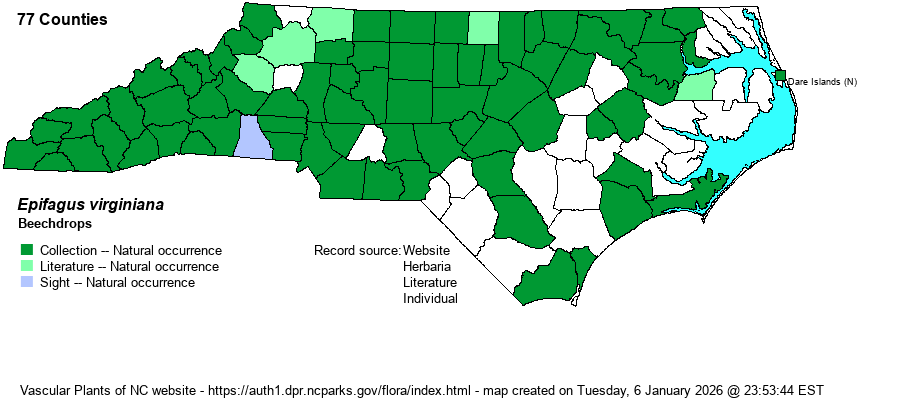| Author | (L.) W.P.C. Barton | |
| Distribution | Throughout the Mountains and Piedmont; ranges east to most of the Coastal Plain, but generally very rare to absent in the far eastern areas (with a record from the northern Outer Banks).
This is a widespread Eastern species, ranging from eastern Canada on the north to northern FL and eastern TX. | |
| Abundance | Common across the Mountains and the Piedmont; the odd scarcity in records for the northwestern Piedmont is strange and possibly an artifact of collecting. Uncommon in much of the western and central Coastal Plain, but scarce in much of the southern regions; very rare in the far eastern counties and absent in the Sandhills proper. | |
| Habitat | This species is well-known to be a root parasite on American Beech (Fagus grandifolia). Thus, it can only occur in hardwood forests where that common tree is found. It usually occurs in Mesic Mixed Hardwood Forests, but it can occur in bottomland forests, along wooded streambanks, and in various montane beech forests. |
| Phenology | Blooms from August to November, and fruits shortly after flowering. | |
| Identification | This is a very familiar small species, and lacking chlorophyll many people assume it must be a fungus or some other non-vascular plant. It usually has several stems branching from a common base, reaching a height of 9-12" tall. The plant is dull yellow, golden-yellow, purplish, or brownish overall. Leaves are small and scale-like, of little significance for identification. The top third to half of each stem is the inflorescence, a spike of around 10-12 scattered flowers, each narrow and arranged horizontally, about 1/3-1/2" long, with male flowers at the top part of the stem. The flowers are white with brown to purple stripes, and not at all insignificant, but as with the leaves, they are not needed for identification. The golden to purplish-brown color of the multiple stems, always in the presence of a beech tree, is sufficient. Normally, a group of plants grows along a single beech root; and the dead stems remain over the winter in a brown or blackened state, before they wither away in late winter. | |
| Taxonomic Comments | This is the only species in the genus.
| |
| Other Common Name(s) | None | |
| State Rank | S5 | |
| Global Rank | G5 | |
| State Status | | |
| US Status | | |
| USACE-agcp | | |
| USACE-emp | | |

